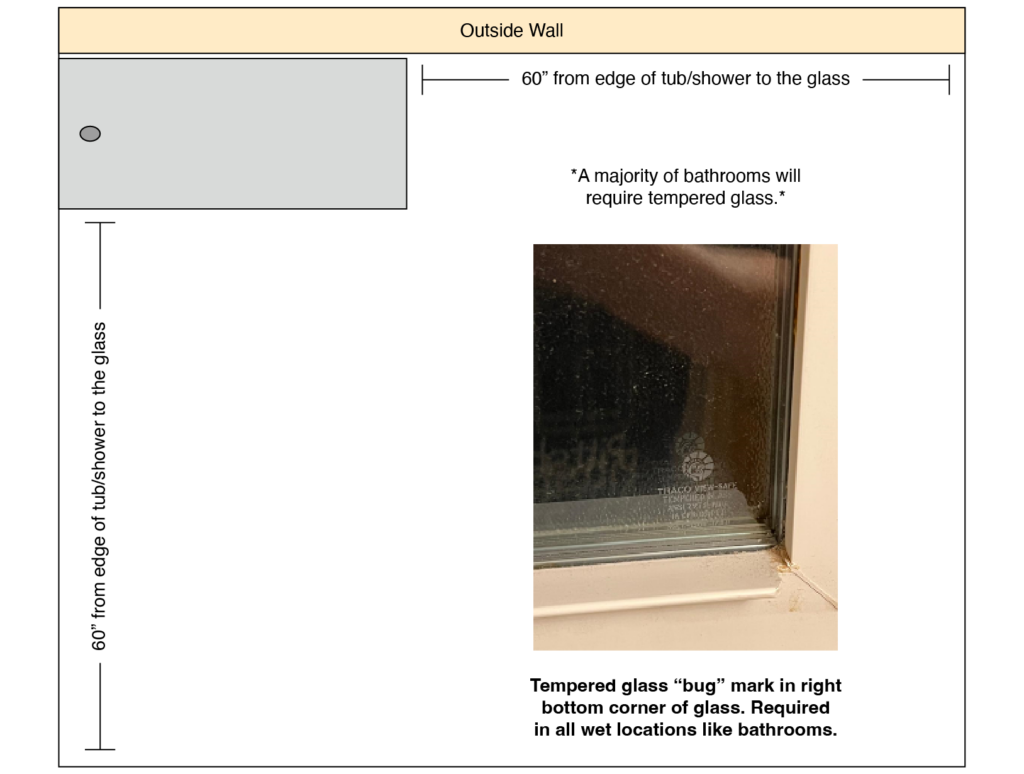Tempered Glass Safety
Glazing Requirements
The International Residential Code (IRC) requires glass in hazardous locations in the home to be tempered.
Tempered Glass in Doors – Glass on all doors and patio doors is tempered, no exceptions.
Tempered Glass Adjacent to Doors – The glass must meet a few parameters here before it is considered a hazardous location.
Glazing in an individual fixed or operable panel next to a door shall be considered to be a hazardous location where the bottom exposed edge of the glazing is less than 60 inches above the floor or walking surface and it meets either of the following conditions:
- Where the glass is within 24 inches of either side of the door in the plane of the door in a closed position.
- Where the glass is on a wall less than 180 degrees from the plane of the door in a closed position and within 24 inches of the hinge side of an in-swinging door.
Glazing in an individual fixed or operable panel next to a door shall be considered to be a hazardous location where the bottom exposed edge of the glazing is less than 60 inches above the floor or walking surface and it meets either of the following conditions:
- Where the glass is within 24 inches of either side of the door in the plane of the door in a closed position.
- Where the glass is on a wall less than 180 degrees from the plane of the door in a closed position and within 24 inches of the hinge side of an in-swinging door.
First, glass that is located parallel to the closed door and within 24 inches of either side of the door must be tempered.
Second, glass that is located perpendicular, or less than 180 degrees, from the plane of a closed door and within 24 inches of the hinge side of an in-swinging door must be tempered.
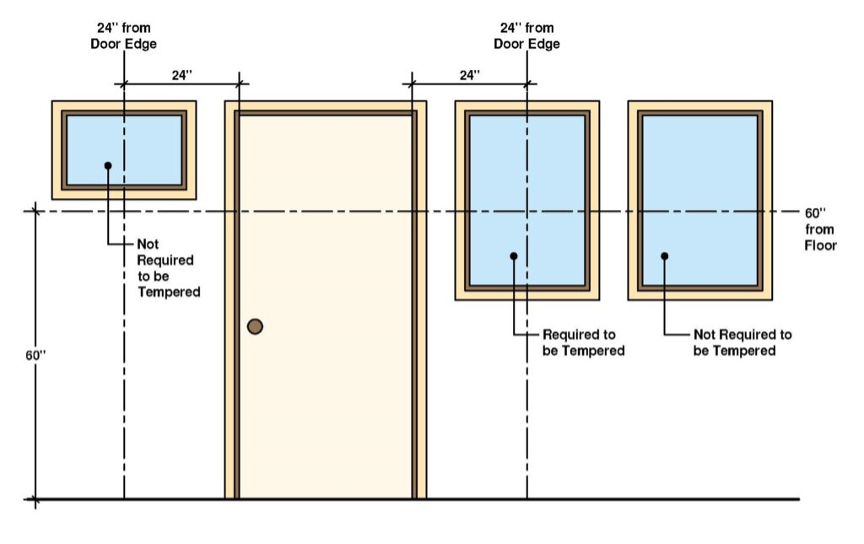
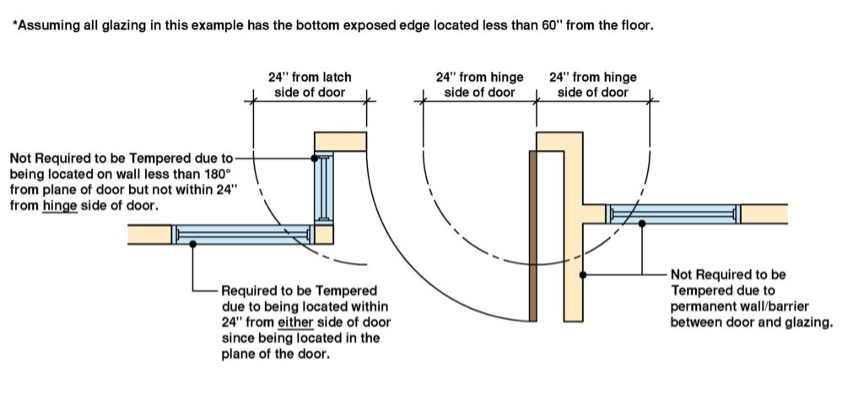
This section, however, has 4 exceptions that will not require tempered glass.
- Where there is an intervening wall or other permanent barrier between the door and the glass.
- Glass that is next to the (non-active) fixed panel of patio doors.
- Where access through the door is to a closet or storage area 3 feet or less in depth. Glass in this application shall comply with Section R308.4.3.
-
Decorative glass.
(DECORATIVE GLASS: A carved, leaded or Dalle glass or glazing material with a purpose that is decorative or artistic, not functional; with coloring, texture or other design qualities or components that cannot be removed without destroying the glazing material; and with a surface, or assembly into which it is incorporated, that is divided into segments.)
*Assuming all glass in this example has the bottom edge less than 60” from the floor.
Reference Source – 2018 International Residential Code
Schedule Your FREE Consultation Today!
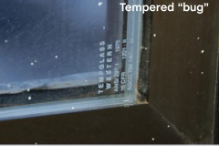
*Tempered glass can be identified by the bug or white etched label in one corner of the window
Tempered Glass in Windows
Per Section R308.4.3 the next hazardous location is glass located in a window. In this section the glass in a window must meet all 4 parameters to be considered hazardous.
In this section the glass in a window must meet all 4 parameters to be considered hazardous.
- The bottom edge of the glass is less than 18 inches above the floor.
- The top edge of the glass is more than 36 inches above the floor.
- One or more walking surfaces are within 36 inches, measured horizontally and in a straight line, of the glazing.
- The exposed area of the glass is larger than 9 square feet.
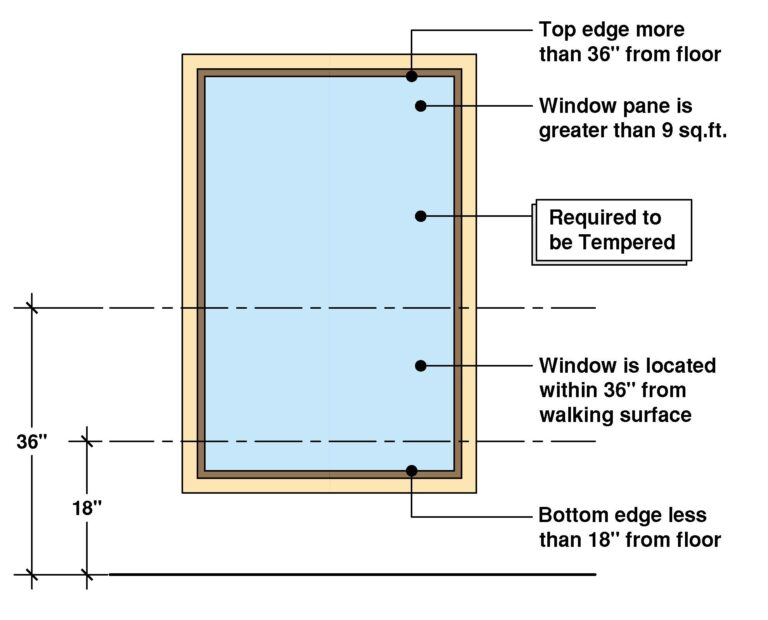
Tempered Glass in Wet Locations
Section R308.4.5 cover glass located in or near wet locations.
Glazing in walls, enclosures or fences containing or facing decks, sidewalks, hot tubs, spas, whirlpools, saunas, steam rooms, bathtubs, showers and indoor or outdoor swimming pools where the bottom exposed edge of the glazing is less than 60 inches measured vertically above any standing or walking surface shall be considered to be a hazardous location. This shall apply to single glazing and each pane in multiple glazing.
When you think of glass in wet locations, most people think of windows located in shower/tub enclosures. However, per the section above you can see that a wet location can be found in many other places of the home.
The key here is when glass is located in walls, enclosures, or fences facing all of the wet locations listed above, it must be tempered where the bottom edge of the glass is located less than 60 inches vertically from the floor. This applies to both single-pane and multiple-pane glazing.
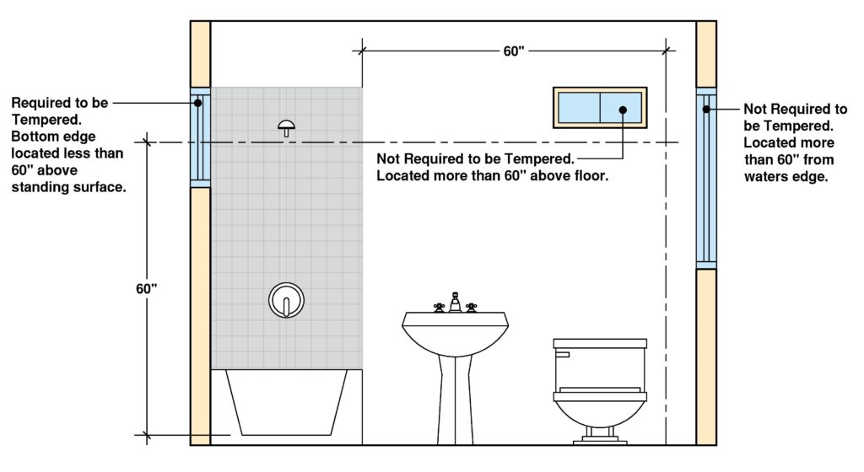
In the above section, we saw that when the bottom edge of the glass is located less than 60 inches vertically above the floor it must be tempered. However, this exception says that regardless of the vertical height, if the glass is located more than 60 inches horizontally from the edge of the water for the features listed above, then it is not required to be tempered. Note, the majority of homes in the Pittsburgh area will require tempered glass in the bathroom(s).
Tempered Glass Adjacent to Stairs and Ramps
When it comes to glass located next to stairs or ramps, Section R308.4.6 reads as follows:
Glass where the bottom exposed edge of the glass is less than 36 inches above the plane of the adjacent walking surface of stairways, landings between flights of stairs, and ramps shall be considered to be a hazardous location.
When glass is adjacent to a stairway, stair landing, or ramp, and where the bottom of the glass is located less than 36 inches above the walking surface of these features, then it is required to be tempered.
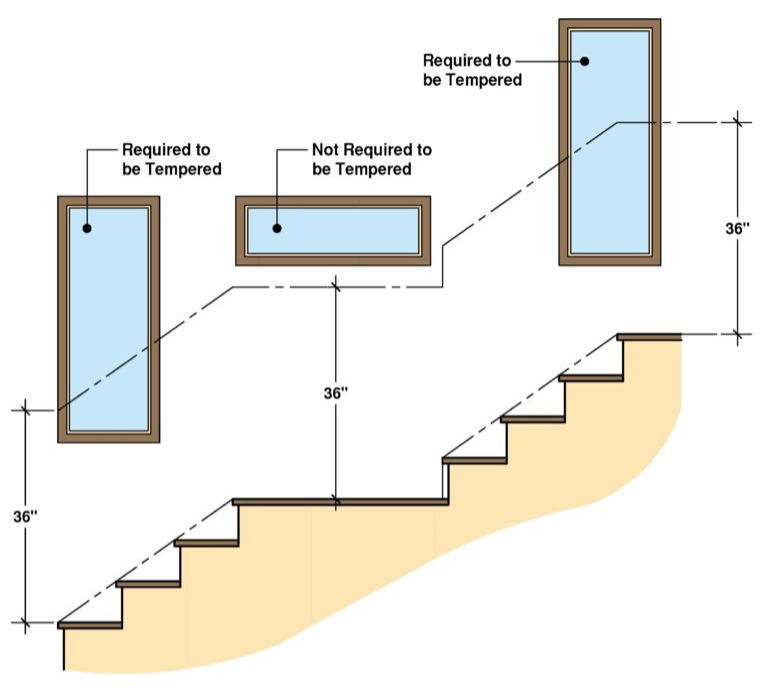
Exception: If a horizontal guardrail is provided along the walking surface adjacent to the glass that is located between 34 to 38 inches above the floor, then the glass is not required to be tempered. This guardrail, however, must be able to withstand a horizontal load of 50 pounds per linear foot and have a cross-sectional height of no less than 1-1/2 inches.
As for the second exception when the glass, regardless of the vertical height, is located 36 inches or more horizontally away from the walking surface it is not required to be tempered.
Tempered Glass Adjacent to the Bottom of Stair Landings
This is the final hazardous location on this list. Section R308.4.7 covers glass located next to the bottom of a stair landing.
Glass adjacent to the landing at the bottom of a stairway where the glass is less than 36 inches above the landing and within a 60-inch horizontal arc less than 180 degrees from the bottom tread nosing shall be considered to be a hazardous location.
In this section, glass that is less than 36 inches above the landing and within a 60-inch dimension at any point along the nosing of the bottom tread measured horizontally must be tempered.
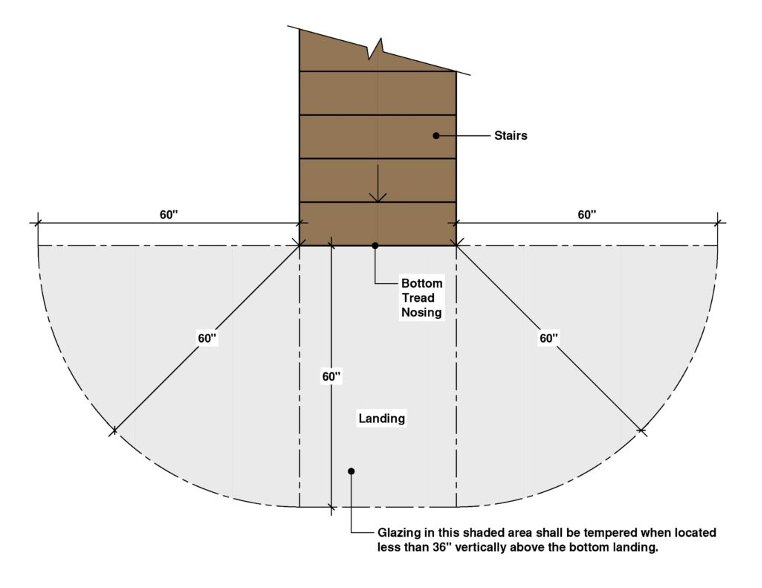
Where the glass is protected by a guardrail complying with Section R312 and the plane of the glass is more than 18 inches from the guardrail tempered glass is not required.
Tempered Glass Inside Bathrooms
Section R308.4.5 covers glass located in or near wet locations.
On the right is the typical bathroom in the Pittsburgh area (6’ by 8’). The 60” rule is from the edge of the tub/shower and not the drain.
The majority of bathrooms in our area require tempered glass in windows due to the smaller room size. Tempered glass is overlooked in bathrooms by national franchised “budget” window dealers.
